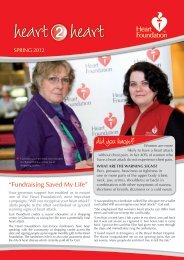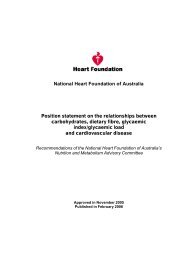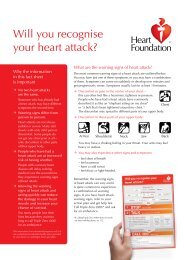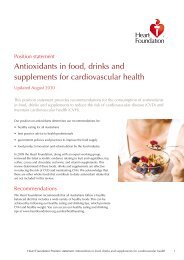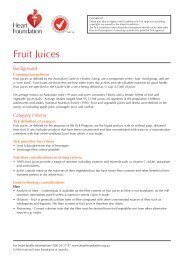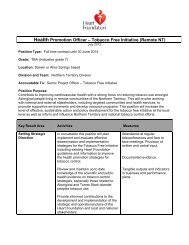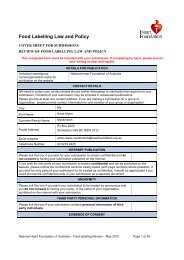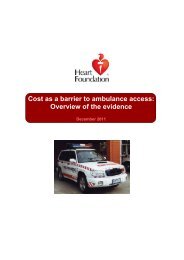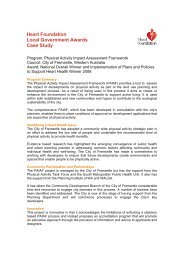Healthy by Design - National Heart Foundation
Healthy by Design - National Heart Foundation
Healthy by Design - National Heart Foundation
You also want an ePaper? Increase the reach of your titles
YUMPU automatically turns print PDFs into web optimized ePapers that Google loves.
09 10<br />
• Provide continuous footpaths, uninterrupted <strong>by</strong> variations in<br />
surface material.<br />
• Keep paths clear, accessible and free of obstructions such as<br />
vegetation and tree debris. Develop a maintenance regime to<br />
ensure vegetation does not overhang walking and cycling paths<br />
and restrict access for users.<br />
• Prohibit parked cars in driveways that block footpath access.<br />
• Ensure gradients from footpaths to streets are minimal, safe and<br />
comfortable for people with limited mobility and those using<br />
wheelchairs, prams and trolleys.<br />
• Align gradients and ramps with desired paths of travel for<br />
pedestrians and cyclists.<br />
• Ensure a smooth transition from ramps to roads for people<br />
using wheelchairs or prams. Ramps should be at least as wide<br />
as the footpath or marked crossing point to eliminate squeeze<br />
points at transition areas.<br />
Paths, ramps and walkways should comply with AS1428.1, 1428.4 and 4586. For<br />
further information on kerb ramp design, refer to VicRoads specifications and<br />
the Local Government.<br />
Shared path design<br />
A shared path is a designated, signed area for pedestrians,<br />
cyclists, people in wheelchairs and other wheeled vehicles. Users<br />
travel at different speeds along shared paths, so a range of design<br />
elements must be considered. Shared off road paths are<br />
particularly important for learner cyclists and children who ride<br />
their bikes to school.<br />
<strong>Design</strong>ated ‘shared zones’ need wider paths to accommodate safe<br />
travel at different speeds. Shared paths include local access paths<br />
and arterial shared paths. Local access paths provide access to local<br />
facilities and destinations, such as parks, playgrounds, schools and<br />
shops. These paths do not necessarily connect across municipalities<br />
and can be designed for lower speeds and lower volumes of people.<br />
<strong>Design</strong> local access paths at 2.0 to 2.5 metres wide.<br />
Arterial shared paths link multiple regional destinations and also<br />
link to local access paths. Arterial shared paths cater for a better<br />
level of service, larger volumes of people and more continuous<br />
travel. <strong>Design</strong> arterial shared paths at 2.5 to 3.5 metres wide.<br />
When designing shared paths:<br />
• Ensure a durable, non-slip surface and even paving, designed<br />
and constructed for minimal maintenance.<br />
• Keep paths clear, accessible and free of obstructions such as<br />
vegetation and tree debris.<br />
• Maintain a foliage set back of at least one metre from the edge<br />
of shared paths.<br />
• Ensure gentle gradients and turns.<br />
• Mark centre lines to delineate two-way traffic and encourage<br />
users to keep left.<br />
In high use areas, it may be more appropriate to create separate<br />
walking and cycling paths.<br />
For further information on shared path design, refer to:<br />
• Bicycle Victoria’s toolbox to help traffic engineers to design local streets that are<br />
safer for cyclists and walkers. Visit www.bv.com.au (Search: Campaigns – Toolbox).<br />
• VicRoads Cycle Notes No.3: Shared Bicycle/Pedestrian Path <strong>Design</strong>. Visit<br />
www.vicroads.vic.gov.au.<br />
• Austroads ‘Guide to Traffic Engineering Practice. Part 14 – Bicycles’.



